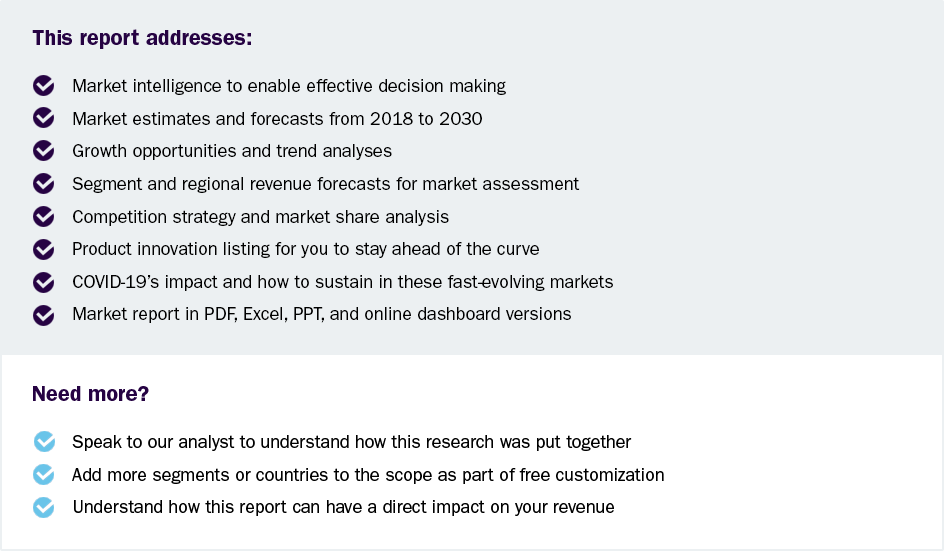
Augmented Reality Navigation Market Size, Share & Trends Analysis Report By Component (Hardware, Software), By Type (Indoor Navigation, Outdoor Navigation), By End-use, By Region, And Segment Forecasts, 2025 - 2030
- Report ID: GVR-4-68040-505-9
- Number of Report Pages: 150
- Format: PDF
- Historical Range: 2018 - 2024
- Forecast Period: 2025 - 2030
- Industry: Technology
AR Navigation Market Size & Trends
The global augmented reality navigation market size was estimated at USD 1.62 billion in 2024 and is expected to grow at a CAGR of 39.1% from 2025 to 2030. The market growth is primarily driven by the significant innovations in augmented reality (AR) hardware and software, and the rise of smart devices. Additionally, the advancements in AR technology, wearables, and the increasing need for smarter, more efficient navigation solutions. With AR's ability to blend real-world environments with digital information, it has emerged as a transformative tool in sectors such as automotive, healthcare, retail, and transportation, which is expected to present lucrative opportunities for the augmented reality navigation industry in the coming years.
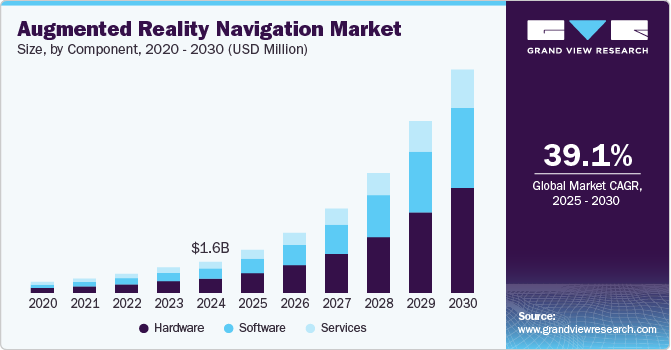
The growing adoption of AR in the automotive sector is driving the augmented reality navigation industry. Car manufacturers are integrating AR navigation systems into vehicles to improve driver safety, reduce distractions, and enhance the overall user experience. These systems provide real-time directions and critical information overlaid on the windshield, allowing drivers to focus on the road while receiving accurate guidance. Additionally, the advent of self-driving vehicles is further boosting the integration of AR in navigation systems, as it supports the seamless flow of data and communication between autonomous vehicles and surrounding environments.
In addition, the rise of smart glasses and wearable devices is another trend propelling the AR navigation market. These devices, including smart eyewear, are being increasingly used for hands-free navigation solutions. Wearables allow users to receive directions, location-based information, and real-time updates directly in their line of sight, making navigation more intuitive and efficient. This shift towards wearable AR devices is especially beneficial in industries such as logistics, field services, and healthcare, where employees require constant, hands-free access to vital information, leading to the expansion of the augmented reality navigation industry.
Furthermore, the growing demand for immersive customer experiences in the retail and tourism sectors is playing a significant role in the expansion of AR navigation technologies. Retailers are incorporating AR-driven in-store navigation systems to enhance customer shopping experiences by guiding them to specific products or promotions within large stores. Similarly, tourism destinations and cities are utilizing AR navigation to provide tourists with immersive, interactive maps and personalized location-based information, improving engagement and satisfaction.
Moreover, the rapid advancements in 5G technology are expected to further accelerate the adoption of AR navigation. With faster data transmission and lower latency, 5G enables real-time processing and streaming of AR content, making it possible to provide highly accurate, responsive, and seamless navigation experiences in diverse environments. As 5G networks continue to expand globally, industries will have greater opportunities to implement AR-based navigation systems on a scale, driving the market’s growth.
Component Insights
The hardware segment recorded the largest revenue share of over 45% in 2024. This growth is driven by the rising demand for AR devices such as smart glasses and headsets. The increasing integration of AR technology in various industries, including manufacturing and retail, has further driven hardware sales as businesses seek innovative solutions to improve productivity and customer engagement. As companies continue to invest in AR hardware for applications like training, remote assistance, and enhanced interaction, this segment is expected to maintain its strong revenue position.
The services segment is projected to register the highest CAGR of 40% from 2025 to 2030. The segmental growth is fueled by the rising adoption of AR applications across multiple sectors. Organizations are recognizing the value of AR software for enhancing training simulations, facilitating remote assistance, and creating immersive experiences in gaming and retail. As businesses continue to invest in digital transformation and seek ways to improve operational efficiency and user engagement, the demand for AR software is expected to grow significantly in the coming years.
End Use Insights
The industrial manufacturing segment accounted for the largest revenue share in 2024, primarily driven by the increasing adoption of AR technologies that enhance productivity, training, and operational efficiency. AR applications such as real-time equipment maintenance, remote assistance, and assembly line monitoring have proven effective in reducing downtime and improving worker performance. The ability to overlay digital information on physical environments allows manufacturers to optimize workflows, minimize errors, and improve safety. As Industry 4.0 initiatives and smart factory adoption continue to rise, augmented reality has become a critical tool in modern manufacturing, solidifying its dominance in this segment.
The healthcare segment is anticipated to record the highest CAGR from 2025 to 2030. This growth is fueled by the increasing demand for innovative solutions that improve patient outcomes and streamline healthcare processes. AR technologies are being utilized for surgical simulations, training medical professionals, and enhancing patient engagement through interactive experiences. The integration of AR in healthcare not only facilitates better training but also supports real-time data visualization during procedures, thereby improving accuracy and efficiency.
Type Insights
The outdoor navigation segment accounted for the largest revenue share in 2024. This growth is primarily attributed to technological advancements that enhance user experiences. AR technology overlays digital information onto the physical environment, making navigation more intuitive and engaging for users. The increasing integration of AR in automotive systems, including real-time data updates and contextual information, significantly improves the navigation experience for drivers. Major automotive players like Volkswagen and Mercedes-Benz are heavily investing in AR navigation technologies, further propelling market growth and consumer adoption.
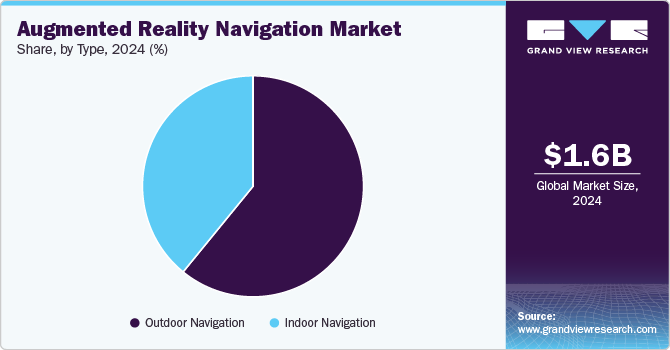
The indoor navigation segment is anticipated to record the highest CAGR from 2025 to 2030. This growth is driven by rapid urbanization and the increasing complexity of indoor environments, such as shopping malls and large commercial spaces. As cities evolve into smart environments, there is a growing need for robust indoor navigation systems that can seamlessly integrate with other smart technologies. The demand for personalized user experiences in retail settings, facilitated by AR navigation, enhances customer engagement and satisfaction, making it a critical driver for this segment's expansion.
Regional Insights
North America augmented reality navigation market accounted for the highest revenue share, over 33.0% in 2024, owing to the rapid adoption of advanced technologies in sectors such as automotive, retail, and healthcare. The U.S. is home to leading tech giants like Apple, Google, and Microsoft, which are spearheading innovations in AR navigation applications for consumer devices, smart cars, and wearable technologies. Additionally, the region’s early adoption of 5G networks enables faster, more efficient AR content delivery, further fueling demand for immersive navigation solutions across industries, including smart city projects and logistics.
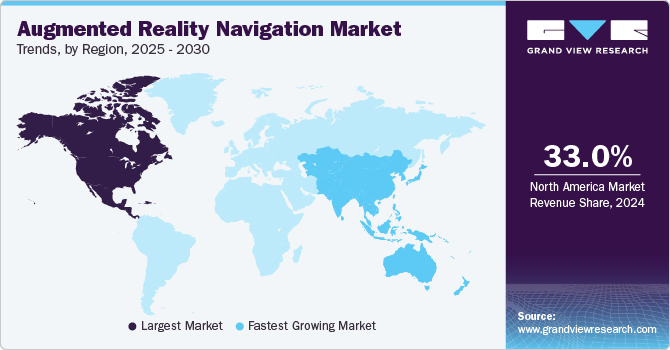
U.S. Augmented Reality Navigation Market Trends
The augmented reality navigation market in the U.S. held a dominant position in 2024, driven by its strong technology infrastructure and increasing adoption of AR in the automotive and consumer electronics sectors. U.S. companies are integrating AR into navigation apps and devices, enhancing user experiences with real-time, location-based information. The rapid expansion of 5G networks and the growing trend of smart cities further boost the demand for AR-driven solutions, enabling more accurate, seamless navigation for both consumers and businesses.
Europe Augmented Reality Navigation Market Trends
The augmented reality navigation market in Europe is expected to grow at a CAGR of over 37% from 2025 to 2030, driven by strong automotive, tourism, and retail sectors. The European Union’s focus on sustainable mobility, digital transformation, and smart cities is enhancing the development of AR-driven solutions for urban planning, public transportation, and navigation. Consumer demand for enhanced in-store shopping experiences and immersive tourism solutions also supports the regional market’s expansion.
The U.K. augmented reality navigation market is expected to grow rapidly in the coming years, owing to the increasing interest in advanced transportation systems, including autonomous vehicles and smart city initiatives. The British government’s focus on digital transformation and sustainability also supports the integration of AR into navigation for eco-friendly transport solutions. The adoption of AR for enhanced wayfinding in urban areas, as well as retail and tourism applications, is helping businesses create more interactive and personalized experiences, further propelling market growth.
The augmented reality navigation market in Germany held a substantial market share in 2024. Germany, known for its automotive industry, is a major adopter of AR navigation technologies, especially in the development of advanced driver-assistance systems (ADAS). AR navigation in vehicles, providing real-time overlays on windshields and dashboards, is transforming the driving experience and increasing safety. The country’s strong emphasis on innovation in automotive technology, coupled with its commitment to Industry 4.0, is driving the widespread adoption of AR navigation solutions, which are becoming integral in both consumer and commercial vehicles.
Asia Pacific Augmented Reality Navigation Market Trends
The augmented reality navigation market in Asia Pacific is projected to grow at the highest CAGR, of over 42% from 2025 to 2030. The augmented reality navigation market is driven by technological advancements in countries such as China, Japan, and South Korea. The surge in smart city projects, particularly in China, is creating demand for AR navigation solutions in public transportation and urban infrastructure. The region’s innovation in robotics and automotive technologies, including AR navigation in self-driving cars and public transport, is a key growth factor. Additionally, the increasing popularity of AR-enabled mobile applications and wearables in APAC is making AR navigation more accessible to a broader consumer base, fostering market expansion.
Japan augmented reality navigation market is expected to grow rapidly in the coming years, owing to the country’s advancements in robotics, automotive innovation, and wearable technologies. Japanese companies are leading the way in the integration of AR navigation into both public transport systems and personal devices like smart glasses. With Japan’s focus on creating high-tech, interconnected urban environments and the growing adoption of autonomous vehicles, AR navigation is expected to play a critical role in shaping the future of mobility and urban planning.
The augmented reality navigation market in China held a substantial market share in 2024. China is rapidly embracing AR navigation technologies, driven by the country’s push toward smart infrastructure and digital transformation in various sectors, including transportation, retail, and urban development. The rise of smart cities in China has created a demand for more efficient, real-time navigation systems. Furthermore, China's major players in the tech industry, such as Huawei and Baidu, are investing heavily in AR navigation for applications in autonomous driving, smart homes, and public transportation, propelling the market forward.
Key Augmented Reality Navigation Company Insights
Some of the key players operating in the market include Google LLC and Microsoft Corporation, among others.
-
Google LLC is leveraging its extensive technological infrastructure and expertise in mapping services. Through innovations such as Google Maps and ARCore, the company has integrated augmented reality features that enhance navigation by overlaying real-time information onto the physical world. This allows users to experience intuitive navigation with visual cues and directions, significantly improving their travel experience.
-
Microsoft Corporation provides a mixed-reality experience that allows users to interact with digital content in their physical environment, making it particularly valuable for industries such as automotive and logistics. The company’s partnerships with various automotive manufacturers to integrate AR navigation systems into vehicles demonstrate its commitment to enhancing driver safety and convenience.
Some of the emerging market players in the augmented reality navigation market include ARway Corp. and WayRay AG, among others
-
ARway Corp. specializes in indoor navigation solutions using augmented reality technology. ARway’s platform enables users to navigate complex environments such as malls, airports, and museums by overlaying digital information onto the physical world. As demand for precise indoor navigation increases, ARway is poised to become a key player in this niche market, leveraging AR to improve user experiences in various venues.
-
WayRay AG is an emerging player focusing on holographic displays for automotive applications. Their innovative technology projects navigation information directly onto the vehicle's windshield, allowing drivers to receive real-time guidance without diverting their attention from the road. WayRay's commitment to enhancing driver safety through augmented reality positions it as a promising company in the AR navigation sector.
Key Augmented Reality Navigation Companies:
The following are the leading companies in the augmented reality navigation market. These companies collectively hold the largest market share and dictate industry trends.
- Google LLC
- Apple, Inc.
- Microsoft Corporation
- WayRay AG
- Neusoft Corporation
- FURUON ELECTRIC CO., LTD.
- ARway Corp.
- Mapbox
- HERE Technologies
- Sygic
Recent Developments
-
In January 2025, Mapbox and Hyundai AutoEver unveiled their next-generation in-car technologies at CES 2025, showcasing an integrated AI voice-driven and ADAS-enabled 3D navigation experience. This innovative system features Mapbox 3D Live Navigation, which offers immersive lane-level guidance and augmented reality overlays, enhancing driver assistance with real-time alerts such as collision warnings.
-
In January 2025, Neusoft Corporation showcased its AI-powered solutions for intelligent mobility at the Consumer Electronics Show (CES) in Las Vegas. Under the theme "Dive In," Neusoft highlighted its commitment to advancing digital transformation in the automotive industry through a range of intelligent products and services.
-
In July 2024, Google LLC introduced innovative augmented reality (AR) features in Google Maps that transform how users explore cities, specifically highlighting Paris. These immersive experiences allow users to engage with historical landmarks in unprecedented ways, such as viewing architectural concepts of the Eiffel Tower from the early 1900s and exploring pavilions built for the 1900 World Fair along the Seine.
Augmented Reality Navigation Market Report Scope:
|
Report Attribute |
Details |
|
Market size value in 2025 |
USD 2.24 billion |
|
Revenue forecast in 2030 |
USD 11.69 billion |
|
Growth rate |
CAGR of 39.1% from 2025 to 2030 |
|
Actual data |
2018 - 2024 |
|
Forecast period |
2025 - 2030 |
|
Quantitative units |
Revenue in USD million/billion and CAGR from 2025 to 2030 |
|
Report coverage |
Revenue forecast, company ranking, competitive landscape, growth factors, and trends |
|
Segments covered |
Component, type, end use, region |
|
Regional scope |
North America, Europe, Asia Pacific, Latin America, and Middle East & Africa |
|
Country scope |
U.S., Canada, Mexico, UK, Germany, France, China, Australia, Japan, India, South Korea, Brazil, South Africa, Saudi Arabia, U.A.E. |
|
Key companies profiled |
Google LLC, Apple Inc., Microsoft Corporation, WayRay AG, Neusoft Corporation, Furuno Electric Co., Ltd., ARway Corp., Mapbox, HERE Technologies, Sygic. |
|
Customization scope |
Free report customization (equivalent to up to 8 analyst’s working days) with purchase. Addition or alteration to country, regional & segment scope. |
|
Pricing and purchase options |
Avail customized purchase options to meet your exact research needs. Explore purchase options |
Global Augmented Reality Navigation Market Report Segmentation
This report forecasts revenue growth at global, regional, and country levels and provides an analysis of the latest technology trends in each of the sub-segments from 2018 to 2030. For this study, Grand View Research has segmented the global augmented reality navigation market report based on component, type, end use, and region:
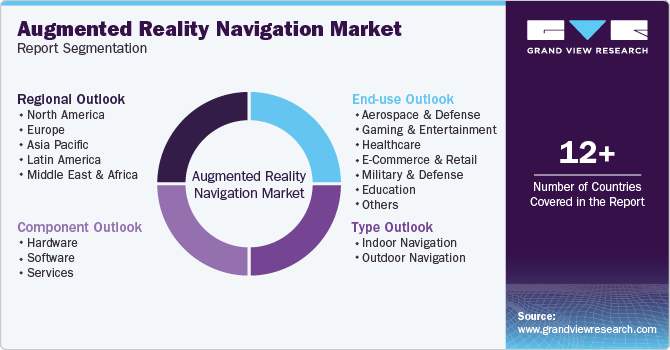
-
Component Outlook (Revenue, USD Million, 2018 - 2030)
-
Hardware
-
Software
-
Services
-
-
Type Outlook (Revenue, USD Million, 2018 - 2030)
-
Indoor Navigation
-
Outdoor Navigation
-
-
End Use Outlook (Revenue, USD Million, 2018 - 2030)
-
Aerospace & Defense
-
Gaming & Entertainment
-
Healthcare
-
E-Commerce & Retail
-
Military & Defense
-
Education
-
Industrial & Manufacturing
-
Others
-
-
Regional Outlook (Revenue, USD Million, 2018 - 2030)
-
North America
-
U.S.
-
Canada
-
Mexico
-
-
Europe
-
UK
-
Germany
-
France
-
-
Asia Pacific
-
China
-
India
-
Japan
-
South Korea
-
Australia
-
-
Latin America
-
Brazil
-
-
Middle East & Africa
-
South Africa
-
Saudi Arabia
-
UAE
-
-
Frequently Asked Questions About This Report
b. The global augmented reality navigation market size was estimated at USD 1.62 billion in 2024 and is expected to reach USD 2.24 billion in 2025.
b. The global augmented reality navigation market is expected to grow at a compound annual growth rate of 39.1% from 2025 to 2030 to reach USD 11.69 billion by 2030.
b. North America dominated the augmented reality navigation market with a share of 33.4% in 2024, owing to the rapid adoption of advanced technologies in sectors such as automotive, retail, and healthcare. The U.S. is home to leading tech giants like Apple Inc., Google LLC, and Microsoft Corporation, which are spearheading innovations in AR navigation applications for consumer devices, smart cars, and wearable technologies.
b. Some key players operating in the augmented reality navigation market include Google LLC, Apple Inc., Microsoft Corporation, WayRay AG, Neusoft Corporation, Furuno Electric Co., Ltd., ARway Corp., Mapbox, HERE Technologies, and Sygic.
b. Key factors that are driving the market growth include the growth of smart devices, and wearables, and the increasing demand for enhanced user experiences are driving the adoption of AR navigation, as consumers seek more interactive, immersive, and hands-free solutions for navigation across various platforms.
We are committed towards customer satisfaction, and quality service.
"The quality of research they have done for us has been excellent."

